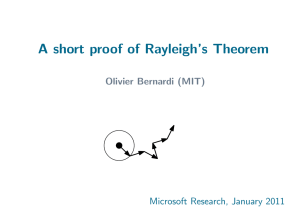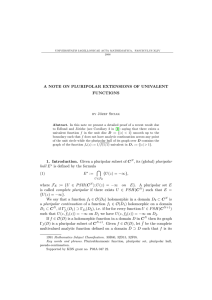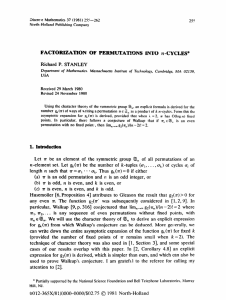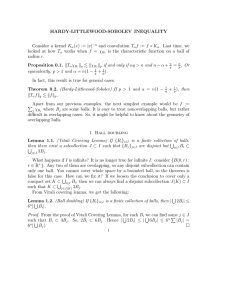Errata
advertisement
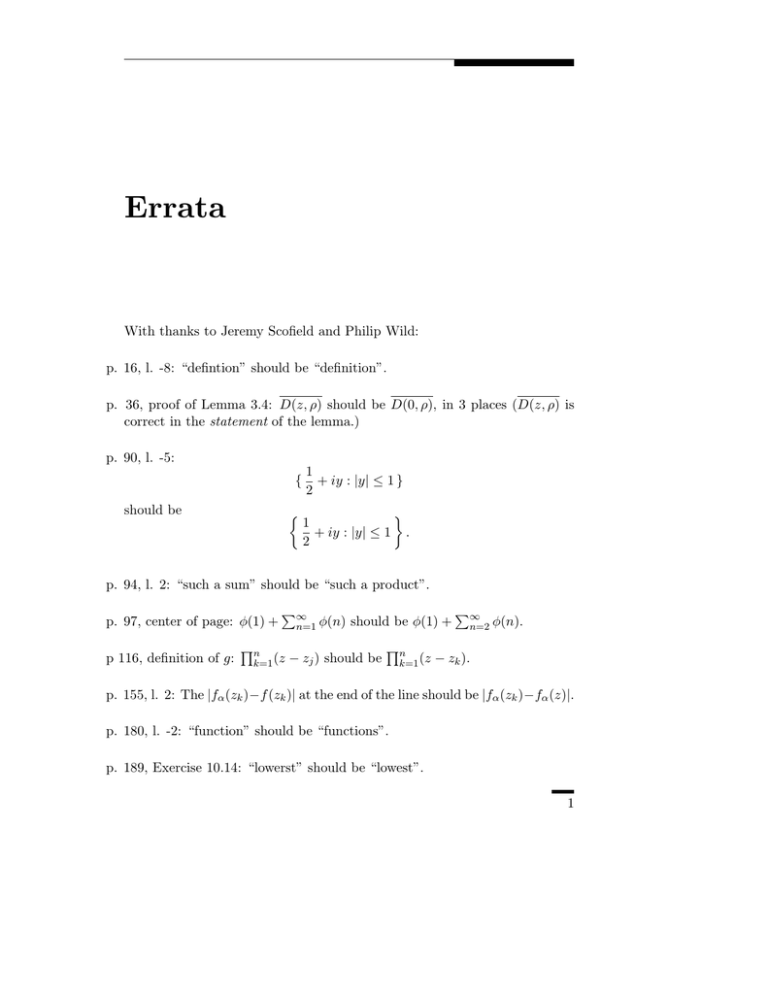
Errata
With thanks to Jeremy Scofield and Philip Wild:
p. 16, l. -8: “defintion” should be “definition”.
p. 36, proof of Lemma 3.4: D(z, ρ) should be D(0, ρ), in 3 places (D(z, ρ) is
correct in the statement of the lemma.)
p. 90, l. -5:
{
should be
1
+ iy : |y| ≤ 1 }
2
1
+ iy : |y| ≤ 1
2
.
p. 94, l. 2: “such a sum” should be “such a product”.
p. 97, center of page: φ(1) +
p 116, definition of g:
Qn
P∞
k=1 (z
n=1 φ(n)
should be φ(1) +
− zj ) should be
Qn
k=1 (z
P∞
n=2 φ(n).
− zk ).
p. 155, l. 2: The |fα (zk )−f (zk )| at the end of the line should be |fα (zk )−fα (z)|.
p. 180, l. -2: “function” should be “functions”.
p. 189, Exercise 10.14: “lowerst” should be “lowest”.
1
2
. Errata
p. 221, Theorem 10.7.5: D ∈ C should be D ⊂ C.
p. 232, Exercise 12.2: “converge to uniformly” should be “converge uniformly”.
p. 234, l. -3: Rα should be R{α} .
p. 239, l. -1: (Re(z) <)0 should be (Re(z) < 0).
p. 249, Theorem 13.2:
M X
r nj
<∞
|zj |
j=1
should be
M X
r nj +1
< ∞.
|zj |
j=1
p. 262, first paragraph in proof of Lemma 14.4: “Fix r ∈ (R, 1)” is not quite
right; we need r sufficiently close to 1 that Cr intersects γ ∗ .
p. 273, display in center of page:
∞
X
n+−∞
should be
∞
X
n=−∞
.
p. 299, l. 2: Extra period after the \qed.
p. 302, l. -13: OG should be O(G).
p. 304, definition of “one-dimensional complex manifold”: We need to add
“Hausdorff” to the definition.
p. 317, Exercise 17.1: The definition of C[f ](z) should mention f :
Z
1
f (w) dw
C[f ](z) =
.
2πi ∂D w − z
p. 321, proof of Lemma 18.0: χ(σ n φ0 ) < χ(φ) should be χ(σ n φ0 ) < χ(φ0 ).
3
. Errata
p. 323, Figure 18.3: The x-axis should not extend into the margin.
p. 343, Theorem 19.0.9: We should assume that Ω is simply connected.
p. 350, end of first paragraph of proof of Theorem 19.3.0: g ◦ g 0 (a) = a should
be g ◦ g 0 (b) = b.
p. 359, Theorem B: f : D0 → R in the statement should be u : D0 → R.
p. 362, first 2 lines: We make comments about “f ” without ever officially
saying what f is: f is the function in D0 “corresponding to” F . That is,
f : D0 → C \ {0, 1} satisfies f (e2πiz ) = F (z).
p. 373, Exercise 21.8:
n
X
j=0
should be
n
X
j=1
.
p. 385, proof of Lemma 23.0.0: Ω∪D(0, R) should be Ω∩D(0, R) in two places.
p 390: “Theorem 23.1.0.” should be “Theorem 23.1.0”.
p. 405, l. 18: “holomoprhic” should be “holomorphic”.
p. 405, last display: log(1 − t/z) should be log(1 + t/z).
p. 410, l. 5: “canot” should be “cannot”.
p. 412, proof of Theorem 24.14: x(x − 1) . . . (x + n − 1)f (x) should be x(x +
1) . . . (x + n − 1)f (x).
p. 422, end of the statement of Theorem 25.1: r(p) = q should be r(b) = c.
p. 424, Lemma 25.4: Intended to assume that f is holomorphic.
p. 430, Lemma 25.4: This is the second Lemma 25.4.
4
. Errata
p. 455, bottom: Should have less empty space above the three displayed formulas and more space between them.
p. 459, hint for Exercise A3.5: Re (z) 6= 0 should be Im (z) 6= 0.
p. 469, Exercise A4.26: Since Appendix 4 is supposed to be self-contained we
need to insert a previous exercise to the effect that a function is continuous
if and only if the inverse image of every open set is open; at present the
suggested solution to Exercise A4.26 makes little sense to a beginner.
p. 477: No error, but a comment from Scofield that should be included:
“By the way, I wanted to convince myself that something like the example in Appendix 6 can happen with a holomorphic covering map. It turns
out to be surprisingly easy. You take a generic cubic polynomial and arrange a figure-eight surrounding its branch points in the image. (This is the
kind of thing that’s probably dead obvious to someone who knows a little
algebraic geometry.) I’ve plotted a graph of the cubic p(z) = z 3 − z, showing
an appropriate figure-eight and its inverse image:
http://homepage.mac.com/jlscofield/cover.png
I color-coded the points and their inverse images, so it’s easy to see that
the large loops double-cover the circles, and the small loops single-cover.
You could clearly fatten the figure-eight to an open set and keep the other
desired properties.”








